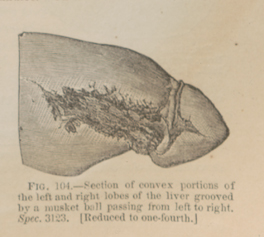Title: I——, Henry L.
Source text: The Medical and Surgical History of the War of the Rebellion. (1861-65.), Part 2, Volume 2 (Washington, DC: Government Printing Office, 1876), 133.
Civil War Washington ID: med.d2e31539
TEI/XML: med.d2e31539.xml
CASE 440.—Lieutenant Henry L. I——, 7th South Carolina Battery, aged 38 years, was wounded and captured at the Six Mile House, near Petersburg, August 21, 1864. Surgeon L. W. Read, U. S. V., at the 3d division hospital of the Fifth Corps, and Surgeon W. L. Faxon, 32d Massachusetts, at City Point, describe the injury as inflicted by a conical musket ball entering the epigastrium and shattering the right elbow joint. The wounded officer was conveyed to Washington and placed in Lincoln Hospital on August 24th, under the care of Acting Assistant Surgeon C. B. Wright, who reported the patient as "ænemic from loss of blood, the countenance anxious, the pulse tolerably strong at 95." There appears to have been no nausea, since the patient took beef-tea and stimulants without inconvenience. There was no jaundice. On the 25th and 26th, the pulse became smaller and more frequent, and the patient complained of loss of sight. Concentrated nourishment and stimulants were retained, but the patient failed rapidly, and died in the afternoon of August 26, 1864, five days after the reception of the injury. Acting Assistant Surgeon H. M. Dean made an autopsy on the following day, and preserved the specimen represented in the wood-cut (FIG. 104), with the following memorandum: "Body well nourished; rigor, well marked; height, 5 feet 11½ inches; œsophagus normal. Lining membranes of larynx and trachea were of a pinkish hue. Posterior portion of lower lobe of each lung was very much congested; otherwise the lungs appeared normal; right weighed 20 ounces; left, 15½ ounces. Pericardium normal. The right side of the heart contained a large black clot; left cavities empty; organ healthy; weight, 9½ ounces. Spleen considerably enlarged and pulpy; weight, 14 ounces. Liver, the ball crossed its superior surface, injuring both the right and left lobe; organ weighed 76½ ounces. Both kidneys were healthy; right weighed 6 ounces; left, 6½ ounces."
